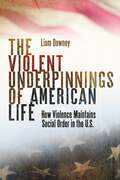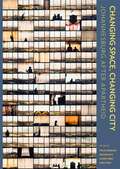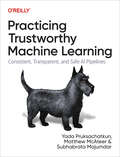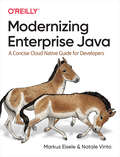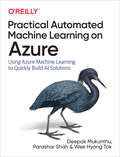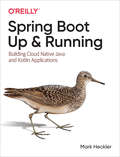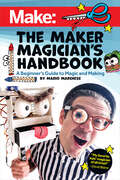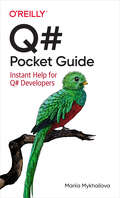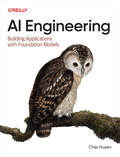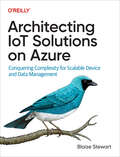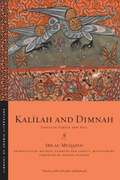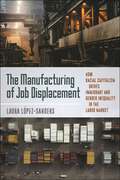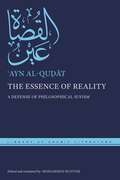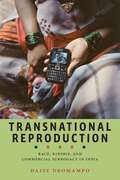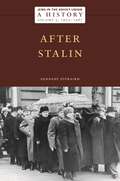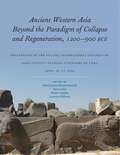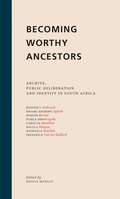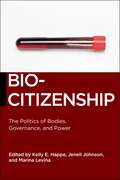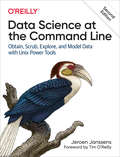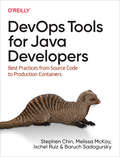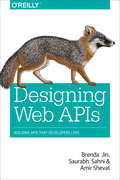- Table View
- List View
The Violent Underpinnings of American Life: How Violence Maintains Social Order in the US
by Liam DowneyA damning examination of how violence serves to maintain social order and elite power in the United StatesThe Violent Underpinnings of American Life boldly asserts that violence—far from going against American ideals—is as American as apple pie, central to the country’s social order and the dominance of its most powerful groups. Drawing from extensive research and analysis of key social, political, and cultural events, Liam Downey investigates the myriad ways violence maintains the American way of life. Through compelling case studies, Downey identifies four main ways in which violence produces and maintains the American social hierarchy: the creation of divisions among non-elite social groups; the reinforcement of dominant discourses in multiple social arenas; the aligning of marginalized group identities with dominant institutional practices; and the selective promotion of the interests of specific, non-elite groups.This is the first book to argue that violence is both a negative, coercive power and a positive, productive one that helps produce not only social order but also consent, discipline, discourse, identity, subjectivity, and embodied knowledge, among other things. The Violent Underpinnings of American Life is an audacious work that argues violence is absolutely central to social life in America, and that Americans cannot effectively fight against the inequalities that surround them without accepting this reality.
Frederick Law Olmstead: The Passion of a Public Artist (The American Social Experience #13)
by Melvin KalfusFrederick Law Olmsted is famous for his urban landscape designs: Central Park in Manhattan, Prospect Park in Brooklyn, and Franklin Park in Boston. Olmsted devoted much of his later life to this work. What was the source of this creative energy and imagination in his fascinating years? Melvin Kalfus is the first author to examine Olmsted's troubled, sometimes tragic childhood and adolescence in a search for the inner sources of his creative imagination. Kalfus argues that Olmsted's distressing early experiences fired his ambition and led him so obsessively to seek the world's esteem through his works. Kalfus also looks at Olmsted's varied early career during which he worked as an apprentice merchant, a seaman, a farmer, a manager of a mining plantation in California, a journalist, and author of three istorically important books on slavery, and as the General Secretary of the Civil War's Sanitary Commission, and enormous project organized to provide medical aid to Union soldiers.
Changing Space, Changing City: Johannesburg after apartheid - Open Access selection
by Graeme Gotz Alison Todes Chris Wray Philip HarrisonAs the dynamo of South Africa’s economy, Johannesburg commands a central position in the nation’s imagination, and scholars throughout the world monitor the city as an exemplar of urbanity in the global South. This book offers detailed empirical analyses of changes in the city’s physical space, as well as a host of chapters on the character of specific neighbourhoods and the social identities being forged within them. Informing all of these is a consideration of underlying economic, social and political processes shaping the wider Gauteng province. A mix of respected academics, practising urban planners and experienced policymakers offer compelling overviews of the rapid and complex spatial developments that have taken place in Johannesburg since the end of apartheid, along with tantalising glimpses into life on the streets and behind the high walls of this diverse city. The book has three sections. Section A provides an overview of macro spatial trends and the policies that have influenced them. Section B explores the shaping of the city at district and suburban level, revealing the peculiarity of processes in different areas. This analysis elucidates the larger trends, while identifying shifts that are not easily detected at the macro level. Section C is an assembly of chapters and short vignettes that focus on the interweaving of place and identity at a micro level.With empirical data supported by new data sets including the 2011 Census, the city’s Development Planning and Urban Management Department’s information system, and Gauteng City-Region Observatory’s substantial archive, the book is an essential reference for planning practitioners, urban geographers, sociologists, and social anthropologists, among others.
Production Kubernetes
by John Harris Josh Rosso Rich Lander Alex BrandKubernetes has become the dominant container orchestrator, but many organizations that have recently adopted this system are still struggling to run actual production workloads. In this practical book, four software engineers from VMware bring their shared experiences running Kubernetes in production and provide insight on key challenges and best practices.The brilliance of Kubernetes is how configurable and extensible the system is, from pluggable runtimes to storage integrations. For platform engineers, software developers, infosec, network engineers, storage engineers, and others, this book examines how the path to success with Kubernetes involves a variety of technology, pattern, and abstraction considerations.With this book, you will:Understand what the path to production looks like when using KubernetesExamine where gaps exist in your current Kubernetes strategyLearn Kubernetes's essential building blocks--and their trade-offsUnderstand what's involved in making Kubernetes a viable location for applicationsLearn better ways to navigate the cloud native landscape
Practicing Trustworthy Machine Learning: Consistent, Transparent, and Fair AI Pipelines
by Yada Pruksachatkun Matthew Mcateer Subho MajumdarWith the increasing use of AI in high-stakes domains such as medicine, law, and defense, organizations spend a lot of time and money to make ML models trustworthy. Many books on the subject offer deep dives into theories and concepts. This guide provides a practical starting point to help development teams produce models that are secure, more robust, less biased, and more explainable.Authors Yada Pruksachatkun, Matthew McAteer, and Subhabrata Majumdar translate best practices in the academic literature for curating datasets and building models into a blueprint for building industry-grade trusted ML systems. With this book, engineers and data scientists will gain a much-needed foundation for releasing trustworthy ML applications into a noisy, messy, and often hostile world.You'll learn:Methods to explain ML models and their outputs to stakeholdersHow to recognize and fix fairness concerns and privacy leaks in an ML pipelineHow to develop ML systems that are robust and secure against malicious attacksImportant systemic considerations, like how to manage trust debt and which ML obstacles require human intervention
Modernizing Enterprise Java: A Concise Cloud Native Guide for Developers
by Markus Eisele Natale VintoWhile containers, microservices, and distributed systems dominate discussions in the tech world, the majority of applications in use today still run monolithic architectures that follow traditional development processes. This practical book helps developers examine long-established Java-based models and demonstrates how to bring these monolithic applications successfully into the future.Relying on their years of experience modernizing applications, authors Markus Eisele and Natale Vinto walk you through the steps necessary to update your organization's Java applications. You'll discover how to dismantle your monolithic application and move to an up-to-date software stack that works across cloud and on-premises installations.Learn cloud native application basics to understand what parts of your organization's Java-based applications and platforms need to migrate and modernizeUnderstand how enterprise Java specifications can help you transition projects and teamsBuild a cloud native platform that supports effective development without falling into buzzword trapsFind a starting point for your migration projects by identifying candidates and staging them through modernization stepsDiscover how to complement a traditional enterprise Java application with components on top of containers and Kubernetes
Practical Automated Machine Learning on Azure: Using Azure Machine Learning to Quickly Build AI Solutions
by Wee Hyong Tok Parashar Shah Deepak MukunthuDevelop smart applications without spending days and weeks building machine-learning models. With this practical book, you’ll learn how to apply automated machine learning (AutoML), a process that uses machine learning to help people build machine learning models. Deepak Mukunthu, Parashar Shah, and Wee Hyong Tok provide a mix of technical depth, hands-on examples, and case studies that show how customers are solving real-world problems with this technology.Building machine-learning models is an iterative and time-consuming process. Even those who know how to create ML models may be limited in how much they can explore. Once you complete this book, you’ll understand how to apply AutoML to your data right away.Learn how companies in different industries are benefiting from AutoMLGet started with AutoML using AzureExplore aspects such as algorithm selection, auto featurization, and hyperparameter tuningUnderstand how data analysts, BI professions, developers can use AutoML in their familiar tools and experiencesLearn how to get started using AutoML for use cases including classification, regression, and forecasting.
Gatsby: Build and Deploy Highly Performant Jamstack Sites and Applications
by Preston SoGet the definitive guide on Gatsby, the JavaScript framework for building blazing fast websites and applications. Used by Nike, Costa Coffee, and other companies worldwide, Gatsby is emerging as one of the key technologies in the Jamstack (JavaScript, APIs, and markup) ecosystem. With this comprehensive guide, you'll learn how to architect, build, and deploy Gatsby sites independently or with CMSs, commerce systems, and other data sources.Author Preston So begins by showing you how to set up a Gatsby site from scratch. From there, you'll learn ways to use Gatsby's declarative rendering and GraphQL API, build complex offline-enabled sites, and continuously deploy Gatsby sites on a variety of platforms, including Gatsby Cloud.Discover how Gatsby integrates with many data sources and plug-insSet up, configure, and architect Gatsby sites using Gatsby's CLI, React, JSX, and GraphQL with high performance out of the boxBuild an independent Gatsby site based on Markdown and data- and content-driven Gatsby sites that integrate with CMSs and commerce platformsDeploy Gatsby sites with full CI/CD and test coverage on a variety of platforms, including Netlify, Vercel, and Gatsby Cloud
Spring Boot: Building Cloud Native Java And Kotlin Applications
by Mark HecklerWith over 75 million downloads per month, Spring Boot is the most widely used Java framework available. Its ease and power have revolutionized application development from monoliths to microservices. Yet Spring Boot's simplicity can also be confounding. How do developers learn enough to be productive immediately? This practical book shows you how to use this framework to write successful mission-critical applications.Mark Heckler from VMware, the company behind Spring, guides you through Spring Boot's architecture and approach, covering topics such as debugging, testing, and deployment. If you want to develop cloud native Java or Kotlin applications with Spring Boot rapidly and effectively (using reactive programming, building APIs, and creating database access of all kinds) this book is for you.Learn how Spring Boot simplifies cloud native application development and deploymentBuild reactive applications and extend communication across the network boundary to create distributed systemsUnderstand how Spring Boot's architecture and approach increase developer productivity and application portabilityDeploy Spring Boot applications for production workloads rapidly and reliablyMonitor application and system health for optimal performance and reliabilityDebug, test, and secure cloud-based applications painlessly
The Maker Magician's Handbook: A Beginner's Guide to Magic + Making
by Mario MarcheseTo get started, you'll need only what you can usually find in your home: items like paper, ziploc bags, index cards, coloring utensils, pencils, rubberbands, scissors, etc. As we progress in the world of making magic, we'll explore how to use 3D design tools like Tinkercad (you can register for a free account at tinkercad.com). You don't need a 3D printer in your home! Libraries, schools, and makerspaces around the world have 3D printers you can use! We'll explore simple programming using Arduino!
Q# Pocket Guide: Instant Help for Q# Developers
by Mariia MykhailovaReady to build quantum computing applications using Q# and the Microsoft Quantum Development Kit? This is the book for you. Q# is a domain-specific language for expressing quantum algorithms that combines familiar "classical" language constructs with quantum-specific ones. Ideal for any developer familiar with (or willing to learn) the basics of quantum computing and looking to get started with quantum programming, this pocket guide quickly helps you find syntax and usage information for unfamiliar aspects of Q#.You'll explore the quantum software development lifecycle from implementing the program to running it on quantum simulators to testing and debugging it. You'll learn to use the tools provided by Microsoft's Quantum Development Kit for each step of the process.You'll explore:Q# language details, including data types, statements, and operatorsGuidelines for organizing Q# code and invoking it from different environmentsInformation on simulators and tools in the Microsoft Quantum Development KitAdvice on testing and debugging tools and techniques for quantum programs
AI Engineering: Building Applications with Foundation Models
by Chip HuyenRecent breakthroughs in AI have not only increased demand for AI products, they've also lowered the barriers to entry for those who want to build AI products. The model-as-a-service approach has transformed AI from an esoteric discipline into a powerful development tool that anyone can use. Everyone, including those with minimal or no prior AI experience, can now leverage AI models to build applications. In this book, author Chip Huyen discusses AI engineering: the process of building applications with readily available foundation models.The book starts with an overview of AI engineering, explaining how it differs from traditional ML engineering and discussing the new AI stack. The more AI is used, the more opportunities there are for catastrophic failures, and therefore, the more important evaluation becomes. This book discusses different approaches to evaluating open-ended models, including the rapidly growing AI-as-a-judge approach.AI application developers will discover how to navigate the AI landscape, including models, datasets, evaluation benchmarks, and the seemingly infinite number of use cases and application patterns. You'll learn a framework for developing an AI application, starting with simple techniques and progressing toward more sophisticated methods, and discover how to efficiently deploy these applications.Understand what AI engineering is and how it differs from traditional machine learning engineeringLearn the process for developing an AI application, the challenges at each step, and approaches to address themExplore various model adaptation techniques, including prompt engineering, RAG, fine-tuning, agents, and dataset engineering, and understand how and why they workExamine the bottlenecks for latency and cost when serving foundation models and learn how to overcome themChoose the right model, dataset, evaluation benchmarks, and metrics for your needsChip Huyen works to accelerate data analytics on GPUs at Voltron Data. Previously, she was with Snorkel AI and NVIDIA, founded an AI infrastructure startup, and taught Machine Learning Systems Design at Stanford. She's the author of the book Designing Machine Learning Systems, an Amazon bestseller in AI.AI Engineering builds upon and is complementary to Designing Machine Learning Systems (O'Reilly).
Architecting IoT Solutions on Azure: Conquering Complexity for Scalable Device and Data Management
by Blaize StewartHow can you make sense of the complex IoT landscape? With dozens of components ranging from devices to metadata about the devices, it's easy to get lost among the possibilities. But it's not impossible if you have the right guide to help you navigate all the complexities. This practical book shows developers, architects, and IT managers how to build IoT solutions on Azure. Author Blaize Stewart presents a comprehensive view of the IoT landscape. You'll learn about devices, device management at scale, and the tools Azure provides for building globally distributed systems. You'll also explore ways to organize data by choosing the appropriate dataflow and data storage technologies. The final chapters examine data consumption and solutions for delivering data to consumers with Azure. Get the architectural guidance you need to create holistic solutions with devices, data, and everything in between. This book helps you: Meet the demands of an IoT solution with Azure-provided functionality Use Azure to create complete scalable and secure IoT systemsUnderstand how to articulate IoT architecture and solutions Guide conversations around common problems that IoT applications solve Select the appropriate technologies in the Azure space to build IoT applications
Kalīlah and Dimnah: Fables of Virtue and Vice (Library of Arabic Literature #91)
by Ibn al-MuqaffaʿTimeless fables of loyalty and betrayal Like Aesop’s Fables, Kalīlah and Dimnah is a collection designed not only for moral instruction, but also for the entertainment of readers. The stories, which originated in the Sanskrit Panchatantra and Mahabharata, were adapted, augmented, and translated into Arabic by the scholar and state official Ibn al-Muqaffaʿ in the second/eighth century. The stories are engaging, entertaining, and often funny, from “The Man Who Found a Treasure But Could Not Keep It,” to “The Raven Who Tried To Learn To Walk Like a Partridge” and “How the Wolf, the Raven, and the Jackal Destroyed the Camel.” Kalīlah and Dimnah is a “mirror for princes,” a book meant to inculcate virtues and discernment in rulers and warn against flattery and deception. Many of the animals who populate the book represent ministers counseling kings, friends advising friends, or wives admonishing husbands. Throughout, Kalīlah and Dimnah offers insight into the moral lessons Ibn al-Muqaffaʿ wished to impart to rulers—and readers.An English-only edition.
The Manufacturing of Job Displacement: How Racial Capitalism Drives Immigrant and Gender Inequality in the Labor Market
by Laura López-SandersThe employer-driven push to systematically replace Black workers with unauthorized immigrantsIn The Manufacturing of Job Displacement, Laura López-Sanders argues that the walls of American businesses hide a system of illegal practices and behaviors that lead to racial inequality in the labor market. Drawing on extensive research in South Carolina manufacturing facilities, nearly 300 interviews, and her own experience working at both the “bottom” of the labor market (e.g., cleaning toilets and on assembly-line jobs) and in mid-level supervisory positions, López-Sanders provides a behind-the-scenes accounting of daily factory life.She uncovers preferential hiring practices that fly in the face of civil rights legislation barring employment discrimination, including orchestrated actions of employers to systematically replace Black workers with Hispanic unauthorized immigrants. López-Sanders argues against the predominant view that worker displacement occurs primarily because of hiring biases or social networks. Instead, she shows that employers intervene strategically, relying on subcontractors, agencies, use and intermediaries to shift the race and gender in an organization. They also vulnerable and tractable immigrant labor to impose and justify untenable standards that drive native-born workers out of their jobs and create vacancies to be filled by additional immigrant workers. The Manufacturing of Job Displacement sheds new light on a classic question about ethnic succession and segmentation in the labor market and reorients the ongoing debates about the economic impact of immigration.
The Essence of Reality: A Defense of Philosophical Sufism (Library of Arabic Literature #80)
by ʿAyn al-QuḍātA groundbreaking exposition of Islamic mysticismThe Essence of Reality was written over the course of just three days in 514/1120, by a scholar who was just twenty-four. The text, like its author ʿAyn al-Quḍāt, is remarkable for many reasons, not least of which that it is in all likelihood the earliest philosophical exposition of mysticism in the Islamic intellectual tradition. This important work would go on to exert significant influence on both classical Islamic philosophy and philosophical mysticism.Written in a terse yet beautiful style, The Essence of Reality consists of one hundred brief chapters interspersed with Qurʾanic verses, prophetic sayings, Sufi maxims, and poetry. In conversation with the work of the philosophers Avicenna and al-Ghazālī, the book takes readers on a philosophical journey, with lucid expositions of questions including the problem of the eternity of the world; the nature of God’s essence and attributes; the concepts of “before” and “after”; and the soul’s relationship to the body. All these discussions are seamlessly tied into ʿAyn al-Quḍāt’s foundational argument—that mystical knowledge lies beyond the realm of the intellect.A bilingual Arabic-English edition.
Transnational Reproduction: Race, Kinship, and Commercial Surrogacy in India (Anthropologies of American Medicine: Culture, Power, and Practice #1)
by Daisy DeomampoTransnational Reproduction traces the relationships among Western aspiring parents, Indian surrogates, and egg donors from around the world. In the early 2010s India was one of the top providers of surrogacy services in the world. Drawing on interviews with commissioning parents, surrogates, and egg donors as well as doctors and family members, Daisy Deomampo argues that while the surrogacy industry in India offers a clear example of “stratified reproduction”—the ways in which political, economic, and social forces structure the conditions under which women carry out physical and social reproductive labor—it also complicates that concept as the various actors in this reproductive work struggle to understand their relationships to one another. The book shows how these actors make sense of their connections, illuminating the ways in which kinship ties are challenged, transformed, or reinforced in the context of transnational gestational surrogacy. The volume revisits the concept of stratified reproduction in ways that offer a more robust and nuanced understanding of race and power as ideas about kinship intersect with structures of inequality. It demonstrates that while reproductive actors share a common quest for conception, they make sense of family in the context of globalized assisted reproductive technologies in very different ways. In doing so, Deomampo uncovers the specific racial reproductive imaginaries that underpin the unequal relations at the heart of transnational surrogacy.
Jews in the Soviet Union: After Stalin, 1953–1967, Volume 5
by Gennady EstraikhOffers an analysis of Soviet Jewish society after the death of Joseph StalinAt the beginning of the twentieth century, more Jews lived in the Russian Empire than anywhere else in the world. After the Holocaust, the USSR remained one of the world’s three key centers of Jewish population, along with the United States and Israel. While a great deal is known about the history and experiences of the Jewish people in the US and in Israel in the twentieth century, much less is known about the experiences of Soviet Jews. Understanding the history of Jewish communities under Soviet rule is essential to comprehending the dynamics of Jewish history in the modern world. Only a small number of scholars and the last generation of Soviet Jews who lived during this period hold a deep knowledge of this history. Jews in the Soviet Union, a new multi-volume history, is an unprecedented undertaking. Publishing over the next few years, this groundbreaking work draws on rare access to documents from the Soviet archives, allowing for the presentation of a sweeping history of Jewish life in the Soviet Union from 1917 through the early 1990s.Volume 5 offers a history of Soviet Jewry from the demise of the brutal dictator Joseph Stalin to the military confrontation between Israel and Arab states in 1967 known as the Six-Day War. Both historic events deeply affected Soviet Jews, who numbered over two million in the wake of the Holocaust and still formed at that point the second-largest Jewish population in the world. Stalin’s death led to the release of political prisoners and the reduction of the level of fear in society. The economy was growing and conditions of life were improving. At the same time, the state had doubts about the loyalty of the Jewish population and imposed limitations on their educational and career prospects. The relatively liberal period associated with Nikita Khrushchev’s “thaw” after the Stalinist bitter frost became a prelude to the years when contemplation about, or practical steps toward, emigration to Israel or elsewhere began to play an increasing role in the lives of Soviet Jews. In this pioneering analysis of the “thaw” years in Soviet Jewish history, Gennady Estraikh focuses both on the factors driving emigration and dissent, and on those Jews who were able to attain a high standard of living, and to rise to esteemed positions in managerial, academic, bohemian, and other segments of the Soviet elite.
Ancient Western Asia Beyond the Paradigm of Collapse and Regeneration: Proceedings of the NYU-PSL International Colloquium, Paris Institut National d’Histoire de l’Art, April 16–17, 2019 (ISAW Monographs)
by Maria Grazia Masetti-Rouault, Ilaria Calini, Robert Hawley, and Lorenzo d’AlfonsoNew results and interpretations challenging the notion of a uniform, macroregional collapse throughout the Late Bronze Age Eastern MediterraneanAncient Western Asia Beyond the Paradigm of Collapse and Regeneration (1200–900 BCE) presents select essays originating in a two-year research collaboration between New York University and Paris Sciences et Lettres. The contributions here offer new results and interpretations of the processes and outcomes of the transition from the Late Bronze Age to the Iron Age in three broad regions: Anatolia, northern Mesopotamia, and the Levant. Together, these challenge the notion of a uniform, macroregional collapse throughout the Eastern Mediterranean, followed by the regeneration of political powers. Current research on newly discovered or reinterpreted textual and material evidence from Western Asia instead suggests that this transition was characterized by a diversity of local responses emerging from diverse environmental settings and culture complexes, as evident in the case studies collected here in history, archaeology, and art history. The editors avoid particularism by adopting a regional organization, with the aim of identifying and tracing similar processes and outcomes emerging locally across the three regions. Ultimately, this volume reimagines the Late Bronze–Iron Age transition as the emergence of a set of recursive processes and outcomes nested firmly in the local cultural interactions of western Asia before the beginning of the new, unifying era of Assyrian imperialism.
Becoming Worthy Ancestors: Archive, public deliberation and identity in South Africa
by Xolela MangcuWhy does it matter that nations should care for their archives, and that they should develop a sense of shared identity? And why should these processes take place in the public domain? How can nations possibly speak about a shared sense of identity in pluralistic societies where individuals and groups have multiple identities? And how can such conversations be given relevance in public discussions of reconciliation and development in South Africa? These are the issues that the Public Conversations lecture series – an initiative of the Constitution of Public Intellectual Life Project at Wits University – proceeded from in 2006. Five years later, cross currents in contemporary South Africa have made the resumption of a public debate to clarify the meanings of identity and citizenship even more imperative, and an understanding of ‘archive’ even more urgent. The 2006 lectures were subsequently collected, resulting in this volume which takes its title from Weber’s point, elaborated on in the chapter by Benedict Anderson, that the future asks us to be worthy ancestors to the yet unborn. The book, as did the lecture series, aims to reach a broad and informed reading public because the topic is still of pressing interest in contemporary public discourse. In a changed (and, some might say, degraded) environment of public dialogue, the editor hopes to inspire a re-thinking of the very essence of what it means to be a citizen of South Africa. Becoming Worthy Ancestors aims to make accessible the theoretically informed, sometimes highly academic work of its various contributors. With chapters from high profile international and local contributors, it will be of interest to South African and international audiences. Editing for publication has further enhanced the accessibility of each speaker’s thinking without forfeiting any of its complexity, and the addition of an introductory chapter by the editor contributes to the coherence of the volume. While the target audience is the broad public, the book is based on a core of academic thinking and research.
Biocitizenship: The Politics of Bodies, Governance, and Power (Biopolitics #19)
by Kelly E. Happe Jenell Johnson Marina LevinaA groundbreaking exploration of biocitizenshipCitizenship has a long, complex relationship with the body. In recent years, developments in biomedicine and biotechnology, as well as a number of political initiatives, grassroots efforts, and public policies have given rise to new ways in which bodies shape the idea and practices of citizenship, or what has been called “biocitizenship.” This book, the first collection of essays on the topic of biocitizenship, aims to examine biocitizenship as a mode of political action and expand readers’ understanding of biopolitics. Organized into four distinct sections covering topics including AIDS, drug testing on the mentally ill, and force-feeding prisoners, Biocitizenship delves deep into the relationship between private and public identity, politics, and power. Composed of pieces by leading scholars from a wide variety of disciplines, Biocitizenship offers a clear and comprehensive discussion on biocitizenship, biopolitics, and groups that may be affected by this ever-growing dialogue. Authors address issues familiar to biopolitics scholarship such as gender, sexuality, class, race, and immigration, but also consider unique objects of study, such as incubators, dead bodies, and corporations. Biocitizenship seeks to question who may count as a biological citizen and for what reasons, an essential topic in an age in which the body and its health provide the conditions necessary for political recognition and agency.
Data Science at the Command Line: Obtain, Scrub, Explore, and Model Data with Unix Power Tools
by Jeroen JanssensThis thoroughly revised guide demonstrates how the flexibility of the command line can help you become a more efficient and productive data scientist. You'll learn how to combine small yet powerful command-line tools to quickly obtain, scrub, explore, and model your data. To get you started, author Jeroen Janssens provides a Docker image packed with over 100 Unix power tools--useful whether you work with Windows, macOS, or Linux.You'll quickly discover why the command line is an agile, scalable, and extensible technology. Even if you're comfortable processing data with Python or R, you'll learn how to greatly improve your data science workflow by leveraging the command line's power. This book is ideal for data scientists, analysts, engineers, system administrators, and researchers.Obtain data from websites, APIs, databases, and spreadsheetsPerform scrub operations on text, CSV, HTML, XML, and JSON filesExplore data, compute descriptive statistics, and create visualizationsManage your data science workflowCreate your own tools from one-liners and existing Python or R codeParallelize and distribute data-intensive pipelinesModel data with dimensionality reduction, regression, and classification algorithmsLeverage the command line from Python, Jupyter, R, RStudio, and Apache Spark
DevOps Tools for Java Developers: Best Practices from Source Code to Production Containers
by Stephen Chin Melissa McKay Ixchel Ruiz Baruch SadogurskyWith the rise of DevOps, low-cost cloud computing, and container technologies, the way Java developers approach development today has changed dramatically. This practical guide helps you take advantage of microservices, serverless, and cloud native technologies using the latest DevOps techniques to simplify your build process and create hyperproductive teams.Stephen Chin, Melissa McKay, Ixchel Ruiz, and Baruch Sadogursky from JFrog help you evaluate an array of options. The list includes source control with Git, build declaration with Maven and Gradle, CI/CD with CircleCI, package management with Artifactory, containerization with Docker and Kubernetes, and much more. Whether you're building applications with Jakarta EE, Spring Boot, Dropwizard, MicroProfile, Micronaut, or Quarkus, this comprehensive guide has you covered.Explore software lifecycle best practicesUse DevSecOps methodologies to facilitate software development and deliveryUnderstand the business value of DevSecOps best practicesManage and secure software dependenciesDevelop and deploy applications using containers and cloud native technologiesManage and administrate source control repositories and development processesUse automation to set up and administer build pipelinesIdentify common deployment patterns and antipatternsMaintain and monitor software after deployment
Designing Web APIs: Building APIs That Developers Love
by Amir Shevat Brenda Jin Saurabh SahniUsing a web API to provide services to application developers is one of the more satisfying endeavors that software engineers undertake. But building a popular API with a thriving developer ecosystem is also one of the most challenging. With this practical guide, developers, architects, and tech leads will learn how to navigate complex decisions for designing, scaling, marketing, and evolving interoperable APIs.Authors Brenda Jin, Saurabh Sahni, and Amir Shevat explain API design theory and provide hands-on exercises for building your web API and managing its operation in production. You’ll also learn how to build and maintain a following of app developers. This book includes expert advice, worksheets, checklists, and case studies from companies including Slack, Stripe, Facebook, Microsoft, Cloudinary, Oracle, and GitHub.Get an overview of request-response and event-driven API design paradigmsLearn best practices for designing an API that meets the needs of your usersUse a template to create an API design processScale your web API to support a growing number of API calls and use casesRegularly adapt the API to reflect changes to your product or businessProvide developer resources that include API documentation, samples, and tools
Applied Embedded Electronics: Design Essentials for Robust Systems
by Jerry TwomeyEmbedded controller electronics are at the heart of virtually all modern electronic devices today with a market of more than $86 billion per year and growing. To serve the needs of designers creating products for this huge market, this practical book covers topics crucial for modern electronics design.Author Jerry Twomey examines the methods necessary to help you create a trouble-free integrated system for your product, with an emphasis on hardware design. You'll explore topics from the perspective of real-world applications, including discussions about non-ideal components, noise, and methods for avoiding problematic scenarios.Topics include:Ideal versus actual connections, components, digital, signalsArchitecting an embedded systemDigital interface selection by application, speed, distanceMultivoltage power suppliesHigh frequency power integrityBattery and charging systemsEMI reduction and ESD protectionDriving and sensing peripheralsDigital feedback controlOptimization of power consumption and costSpecialty systems: medical, industrial, aerospacePCB design including manufacturability, yield, and low noiseThis book guides you through all of the techniques listed, which are required for a reliable integrated system. Through extensive illustrations and minimal equations, anyone with an interest in electronics will quickly grasp the ideas discussed.
